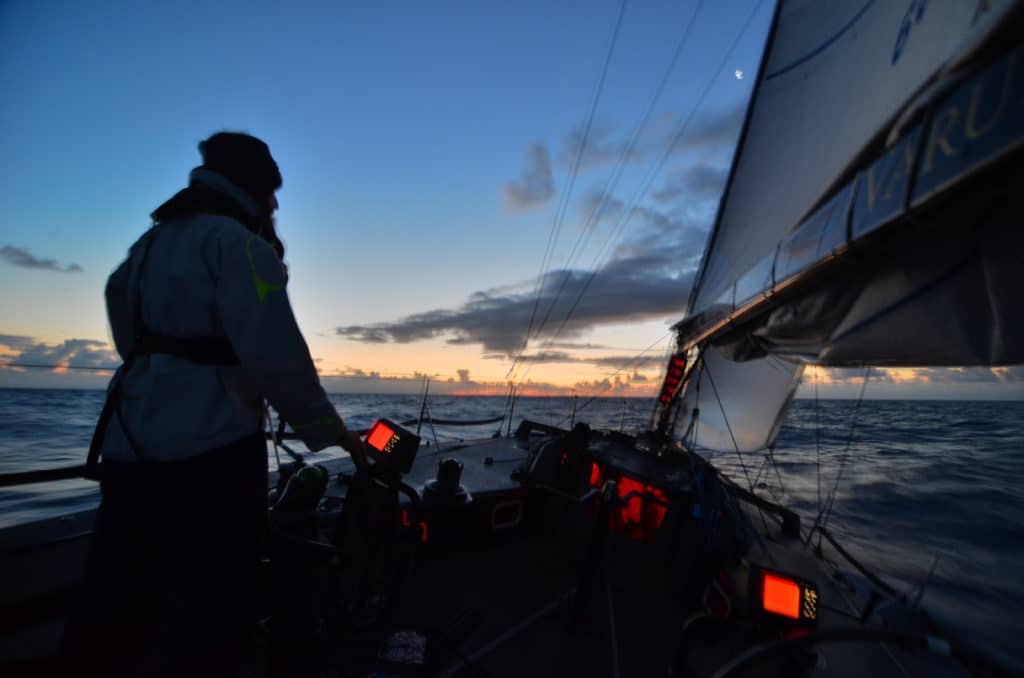
As the first step in a multistage plan to remove half the plastic from the Pacific in a decade’s time, Dutch entrepreneur Boyan Slat and the team from his Ocean Cleanup project launched their Mega Expedition in the summer of 2015. With some 30 vessels traveling through the North Pacific Gyre, including 20 racing yachts, the goal was to conduct research to help map the spatial distribution and density of the rubbish found in what’s come to be known as the Great Pacific Garbage Patch. I was fortunate enough to be the skipper of one of those raceboats.
I arrived with three other crew in Honolulu last August to deliver Chris Hemans’ Newport Beach-based Rogers 46, Varuna, back from the Transpac. Along the way to California, we’d be gathering data for Ocean Cleanup by conducting visual surveys for trash and logging our finds with an intuitive smartphone app. We would also be conducting one-hour trawls with a device called a manta trawl to collect water samples. Our young, keen crew was excited and honored at the prospect of using our good fortune as sailors to benefit such a worthwhile and important cause.
Close-reaching north out of Hawaii for more than 1,000 nautical miles, Varuna — a true reaching machine and a thrill to sail — ate up the distance rapidly. Turning the corner at about 37 degrees N, we began heading east and gradually got into the zone for data collection, which extended from 154 degrees W to 130 degrees W, and 20 degrees N to 40 degrees N. We installed a small collection sock called a cod-end on the manta trawl and collected plastic by towing it 130 feet behind the port side of the boat for an hour at a time. Bringing the manta trawl back to the transom, we’d swap out cod-ends, tow for another hour, and so on. On our first day in the collection zone, we pulled four hour-long trawls.
What we found was incredible. In most of the quart-size cod-end samples, we discovered countless bits of plastic, ranging from small specks to 16-ounce water bottles, broken pieces of laundry baskets, and other junk. There were bottle caps, strands of monofilament fishing line, and little bits of Styrofoam. We also found in every single sample a small ecosystem, with sailor jellies, crabs of various sizes, and other tiny sea creatures scurrying around.
This was my 10th trip between Hawaii and the mainland, and I must admit to never fully appreciating the concentration of garbage before this voyage. Usually, whether on delivery or racing, I’m focused on sailing the boat at speed and therefore miss most of the small plastic, seeing only the big stuff. When we were slowed to a crawl with the specific purpose of looking for plastic, however, a very scary picture was painted. Moving slowly in glassy conditions, it was clear that there were tiny pieces floating everywhere the eye could see, with larger pieces distributed all around. The state of our beloved Pacific Ocean is truly disconcerting. Making matters even more alarming, our latitude at 37 degrees N was several hundred miles north of the most impacted area.
After just one day in the Gyre and with four trawls completed, a new breeze began to fill in from the north, creating quick close-reaching conditions back to the States, which made trawling a challenge. Varuna again began putting up big numbers and quickly made it to 130 degrees W and out of the research box. Along the way, though, we managed to check off three morning-time trawls, bringing our total up to seven. It wasn’t as many trawls as we had originally hoped for, but we knew our data was good, so we were pleased that we had done our best to help the cause.
Not long after Varuna and other boats began arriving back in West Coast ports with their manta trawls and cod-ends full of plastic, the project’s 171-foot mothership, Ocean Starr, arrived in San Francisco to a hero’s welcome of supporters and media. When the large oceangoing research vessel opened up her payload of plastic and rubbish, she told a story, and a sobering one at that. By all estimates, there appears to be more plastic in the North Pacific Gyre than originally feared. Rather than be discouraged at the findings, however, we were only further inspired to help Ocean Cleanup and its supporters achieve their mission.
As environmental issues are brought to the forefront of worldwide debates, the momentum behind those issues becomes too great to ignore for us as a global community. Fortunately, there are organizations like Ocean Cleanup that are attempting to make a difference. Inactivity is no longer an option. For the latest on Ocean Cleanup, visit the organization’s website, www.theoceancleanup.com.








